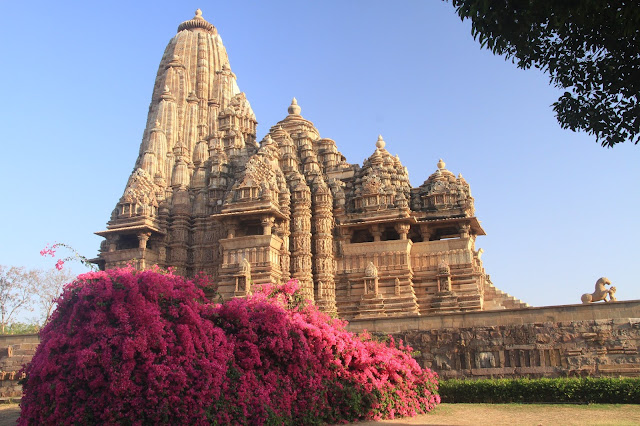T. S. Burt was a British engineer in the rolls of the Company Bahadur. In 1838, during his travels in central India, he was told about the wonders of this place called `Khajraho’. His palanquin bearer conveyed the location of this place, hidden deep in the jungles. Khajuraho had been lost to mankind for more than five centuries after the fall of the Chandellas. That is the underlying story of the rediscovery.
A short drive
from nearby Panna brings us to the UNESCO World Heritage site on an early March
afternoon. The sun is beginning to stamp its authority.
*******
There is a near-complete lack of visitors,
other than a few locals. The rows of outlets that cater to a largely `firang’
crowd round the year look desultory. The pandemic continues to have a telling
effect. We enter the Western group of temples at the break of dawn with two objectives;
to use the `golden hour’ for photographs and to avoid the blazing sun. Its a
surreal experience to have the entire complex to yourself ; not a soul in site,
other than the occasional security personnel.
Opinions of experts indicate that the temples
of Khajuraho may have been built on mounds / islands within a large lake. This
is borne out by the fact that none of the temples have perimeter walls for
protection; also, they stand on high plinths. In his travel writings, Ibn
Batuta mentioned that there was a large lake in Khajuraho, dotted with temples.
Today, the water body has been replaced with manicured ASI gardens. Its surreal
to imagine how this complex would have looked like within a lake, and how on
earth were they constructed ten centuries ago.
******
On the road in India, the English language
morphs into a separate beast that’d hardly be recognizable in Old Blighty. Your
lateral thinking ability is put to test to make sense of what are written at
various places. Sample these…..
The `coolar’ is a mere typo, and an easy one to decipher. I wonder, however, at the thought process of the Captain behind a couple of others. Bianca Castafiore wouldn’t recognize this `Margrita’ (Item 11). In Item #7, orange juice is the only warhead of Citrus Attack. The other ingredients, presumably, are antidotes / defence options for the intestine.
******
The Western group of temples is more touristy.
This is where most visitors focus. It is easy to miss out on a few other gems that
lie beyond this complex. These are not so well organized, though ASI is in
charge. The Southern and Eastern groups have unique architecture that include Vamana (maintaining
a form similar to Kandariya Mahadeva), Chaturbhuj and Brahma temples. You need an
effort to locate these amidst residential colonies. But they are worth it.
And then there are the remnants of Chausath Yogini, just outside the precincts of Western Group. It establishes the tribal origins of the Chandellas and their pagan rituals. The place is eerie.
******
Twenty kilometres out of Khajuraho, hidden
among forests, lies the delightful Raneh Falls. The forest guard informs that most
visitors to Khajuraho give it a miss. The existence of nearby dams hardly
provides a water flow for the falls, except during monsoon. The rock formations
around the falls take your breath away. Five separate layers of igneous rocks
give it the stunning variety of colours; green dolomite, black basalt, brown
quartz, red jasper and pink granite.
Ken Gharial Sanctuary is located a bit further
down the river. With a pair of decent binoculars, you can observe the languid
movements of these fish-eaters in the clear blue waters of Ken.
******









No comments:
Post a Comment